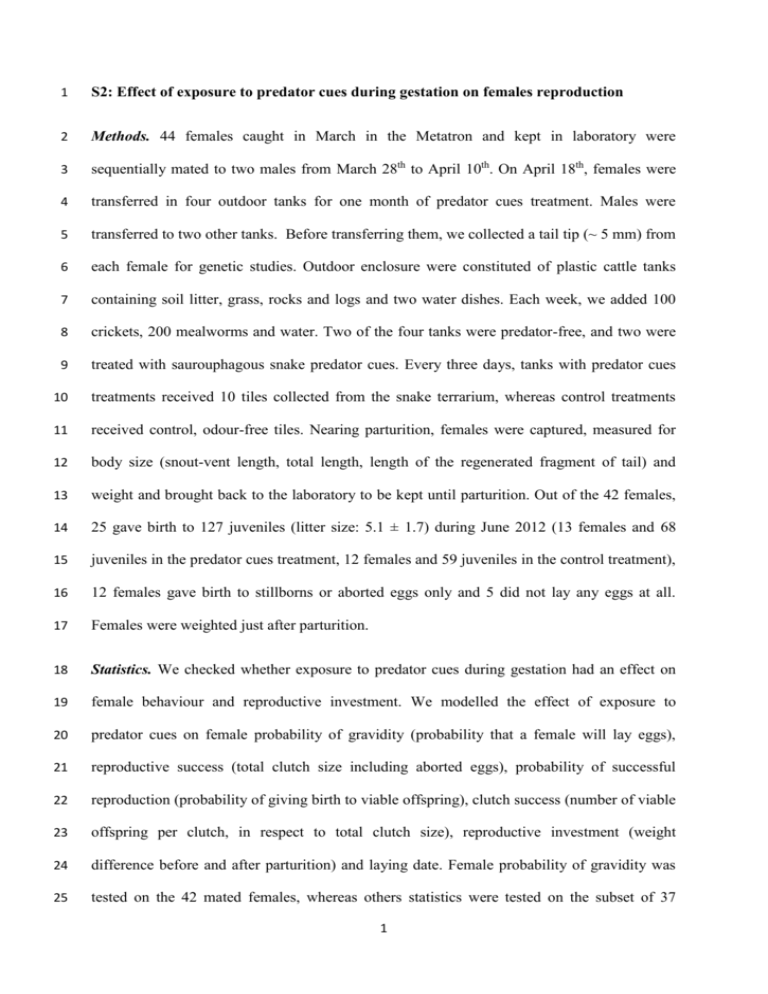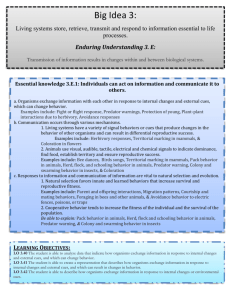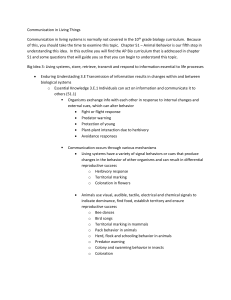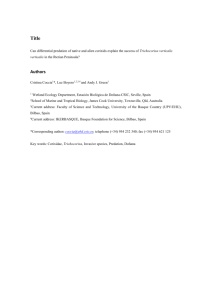Effect of exposure to predator cues during gestation on females
advertisement

1 S2: Effect of exposure to predator cues during gestation on females reproduction 2 Methods. 44 females caught in March in the Metatron and kept in laboratory were 3 sequentially mated to two males from March 28th to April 10th. On April 18th, females were 4 transferred in four outdoor tanks for one month of predator cues treatment. Males were 5 transferred to two other tanks. Before transferring them, we collected a tail tip (~ 5 mm) from 6 each female for genetic studies. Outdoor enclosure were constituted of plastic cattle tanks 7 containing soil litter, grass, rocks and logs and two water dishes. Each week, we added 100 8 crickets, 200 mealworms and water. Two of the four tanks were predator-free, and two were 9 treated with saurouphagous snake predator cues. Every three days, tanks with predator cues 10 treatments received 10 tiles collected from the snake terrarium, whereas control treatments 11 received control, odour-free tiles. Nearing parturition, females were captured, measured for 12 body size (snout-vent length, total length, length of the regenerated fragment of tail) and 13 weight and brought back to the laboratory to be kept until parturition. Out of the 42 females, 14 25 gave birth to 127 juveniles (litter size: 5.1 ± 1.7) during June 2012 (13 females and 68 15 juveniles in the predator cues treatment, 12 females and 59 juveniles in the control treatment), 16 12 females gave birth to stillborns or aborted eggs only and 5 did not lay any eggs at all. 17 Females were weighted just after parturition. 18 Statistics. We checked whether exposure to predator cues during gestation had an effect on 19 female behaviour and reproductive investment. We modelled the effect of exposure to 20 predator cues on female probability of gravidity (probability that a female will lay eggs), 21 reproductive success (total clutch size including aborted eggs), probability of successful 22 reproduction (probability of giving birth to viable offspring), clutch success (number of viable 23 offspring per clutch, in respect to total clutch size), reproductive investment (weight 24 difference before and after parturition) and laying date. Female probability of gravidity was 25 tested on the 42 mated females, whereas others statistics were tested on the subset of 37 1 26 females that actually laid eggs. As reproductive output typically depends on female size, we 27 included female snout-vent length in all models as a covariate. For reproductive investment, 28 the number of number of days between the last weight measurement and parturition was also 29 included as a covariate. Probability of gravidity and probability of successful reproduction 30 were analyzed using a GLM with a binomial distribution and a logit link, whereas 31 reproductive success and clutch success were modelled with a Poisson distribution. As 32 overdispersion was an issue in some of the models, we corrected the standard errors using a 33 quasi-Poisson GLM model. Laying date and reproductive investment were modelled with 34 linear models. Finally, we tested for the effect of exposure to predator cues on female tail 35 regeneration (length of the tail tip regenerated by the females during their stay in the outdoor 36 tanks) using a linear model, with snout-vent length as a covariate. 37 Results. Neither female probability of gravidity nor female successful reproduction 38 probability did depend on the exposure to predator cues during gestation (Table 1). Exposure 39 to predator cues did not affect the total number of eggs laid, the number of viable offspring, 40 the laying date or female reproductive investment (Table 1). However, mothers reacted to 41 predator cues treatments by regenerating longer tails. Tail tips collected for genetic purposes 42 after mating were regenerated during the month spent in the tanks, and females kept in 43 predator cues treatments grew longer tails than females in predator-free treatments (Table 1). 44 Females from predator cues treatments regenerated about 5.7 mm of tail in one month, 2 45 corresponding to 10 % of their original tail length (Fig 1). 46 Table 1: Impact of predator cues treatment during gestation on female reproductive output. 47 Intercept Predator cues Female snouttreatment vent length Estimate SE Estimate SE Estimate SE a Probability of gravidity 0.96 9.94 -0.44 0.99 0.02 0.16 Reproductive success b 0.50 1.5 0.08 0.15 0.02 0.02 c Probability of successful reproduction -9.84 7.63 0.96 0.79 0.17 0.12 Clutch success d -2.01 2.44 0.19 0.20 0.02 0.04 Laying date 11.59 12.63 -1.62 1.27 -0.02 0.20 Female reproductive investment e -4.45 3.53 -0.07 0.05 0.12* 0.06 f Female tail regeneration 5.68 12.10 -3.05* 1.21 0.004 0.20 48 (Probability of gravidity and successful reproduction are modeled using GLM with a binomial 49 distribution and a logit link, reproductive success and clutch success with a Poisson 50 distribution corrected for overdispersion, and other variables are modeled with linear models. 51 All models contain snout-vent length as a covariate.) a 52 Probability of laying eggs b 53 Total clutch size c 54 Probability of giving birth to viable offspring d 55 Number of viable offspring. Model includes total cluch size as a covariate e 56 Weight loss after parturition. Includes number of days between last weight measure and 57 parturition as a covariate. f 58 Mm of tail regenerated during one month spent in outdoor tanks during gestation 59 * p < 0.05 60 3 61 62 Figure 1: Mean female tail regeneration (mm ± SE) after one month depending on the 63 predator cues treatment. P- : females maintained without predator odour cues. P+ : females 64 maintained with predator odour cues. Tail tips from all females were cut at the beginning of 65 the gestation period, before putting them in the cattle tanks for predator cues treatment. After 66 one month, females were retrieved from the cattle tanks and the portion of tail regenerated 67 was measured. 68 4








